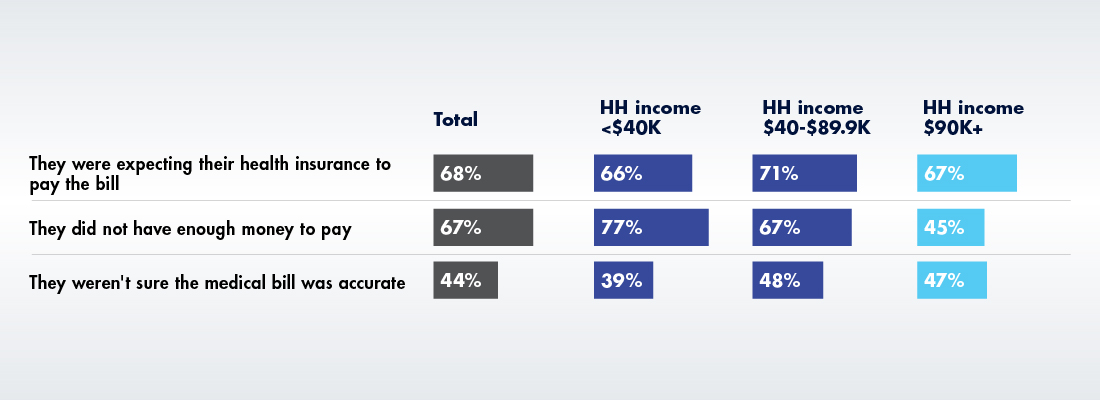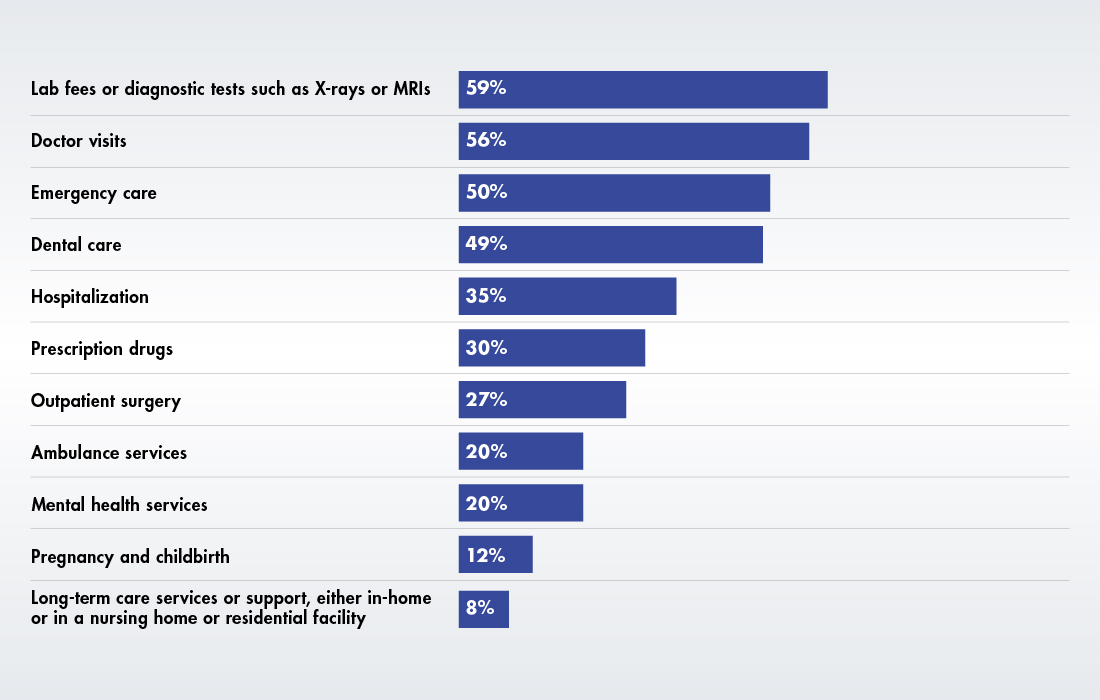Growth of Medical & Consumer Debt Poses New Challenges for Collections
Increasing medical and consumer debt is likely to get worse, meaning billing and collections may get even tougher for labs.

Patient billing and collection is difficult now, and it seems like the situation will only worsen later this year. On the horizon looms a perfect storm of sky-high inflation, rising consumer and medical debt, and new medical credit reporting rules. The storm may burst as soon as August when the federal pause on student loans is scheduled to end, further diverting medical bill payments to other creditors. Here’s a briefing on the medical debt collection situation and how your lab can position itself to ride out the storm.
The Emerging Medical Debt Crisis
While reports of its extent vary depending on how it’s measured, there’s no doubt that medical debt has become a major economic problem in the US. Consider these sobering numbers:
- 45 percent of Americans have medical debt (Debt.com, 2022)1
- 18 percent of Americans have medical debt in collections (Journal of the American Medical Association, 2020)2
- 61 percent of Americans report being late in paying a medical bill (Kaiser Family Foundation/New York Times [KFF/NYT, 2016])3
- 16 million Americans owe more than $1,000 in medical debt (US Census Bureau Survey of Income and Program Participation [SIPP] as reported by KFF, 2022)4
- 3 million Americans owe medical debt of over $10,000 (SIPP/KFF)4
The main reason medical debt is growing is that healthcare costs, including copays, deductibles, and other out-of-pocket amounts paid by individuals who have health insurance are rising faster than income levels. In a 2022 KFF survey, 67 percent of respondents with medical debts list not having enough money as the reason for not fully paying a medical bill in the past five years. But it’s not just money. Confusion over insurance coverage is also a significant issue. Thus, 68 percent of the KFF survey respondents said they didn’t pay a medical bill because they thought their insurance covered it. Another 44 percent cited uncertainty over the accuracy of the bill as a reason for nonpayment.5
Why People Didn’t Pay Their Medical Bills
Percent of KFF survey respondents who said that, in the past five years, they have ever not paid or only partially paid a medical or dental bill sent to them because of each of the following:

Lab and diagnostic tests are the largest source of unpaid medical bills, according to the KFF survey, accounting for 59 percent of medical debt, followed by doctor visits at 56 percent and emergency care at 50 percent.5
Which Medical Bills People Don’t Pay
Percent of KFF survey respondents who say the bills that caused their medical debt were due to:

Medical Bills vs Other Consumer Debts
Rising medical debts mean labs and other healthcare providers will have to work harder to get paid. The challenge won’t be purely a matter of volume in the form of more bills to collect. In seeking payment, labs will also have to compete with patients’ other creditors. That includes not just other medical bills but also mortgages, credit cards, auto loans, and other non-medical debts. According to the US Consumer Financial Protection Bureau (CFPB), approximately 56 percent of medical collections involve consumers who also had at least one credit card account and 55 percent are associated with consumers who also had auto loans.6
Competition from auto loans could be particularly troubling. With inflation eating away at income gains, many consumers have less money to pay the big car loans they had to take out when vehicle shortages during the pandemic caused car prices to soar. According to a February 23, 2023 Wall Street Journal report, an increasing number of Americans are falling behind on their car payments. The report cites a Moody’s Analytics analysis finding that 9.3 percent of auto loans made to persons with low credit scores were at least 30 days behind on car payments at the end of 2022, the highest level since 2010.7
And then there’s the student loan factor. As of 2022, about 43.5 million Americans have federal student loans, 9.9 million of whom have between $20,000 to $40,000 in student loan debt, according to the U.S. Department of Education.8 The federal government put those debts on hold during the pandemic. After several extensions, the forgiveness period is set to expire in August. However, the situation remains unclear. Adding to the uncertainty is the pending Supreme Court case challenging President Biden’s plan to forgive $10,000 to $20,000 in federal student loan debt per eligible borrower.9 However, regardless of what happens with the forgiveness proposal, student loan payments are likely to resume some time in 2023.
Why It Will Be Hard for Labs to Compete with Other Consumer Creditors
In the competition for consumer debt dollars, labs and other healthcare providers face distinct disadvantages. First and foremost, interest on medical debt is typically much lower than interest on other forms of consumer debt. In many cases, medical debt is totally interest free.
Paying medical bills also carries less urgency than paying mortgage, car, credit card, and other consumer debts. Given the choice between keeping their home or car and paying their lab, it’s pretty easy to predict where debtors will direct their limited dollars. Medical debtors also generally have some room to maneuver and can negotiate with the provider for more time, less stringent terms of payment, and even reduction of the payment amount, especially if they have health insurance. There’s also a built-in time buffer. Medical debts generally don’t go to collection until they’re three months past due. Moreover, the major credit reporting bureaus offer a 180-day grace period before listing the delinquent debt on the patient’s credit report.
That doesn’t mean labs are completely without leverage. Knowing that the lab may refer the debt to collection incentivizes patients to pay the bill to prevent damage to their all-important credit score. But even that leverage may no longer be as weighty as it once was. On July 1, 2022, the nation’s three largest credit bureaus—Equifax, Experian, and TransUnion—took steps to relieve consumers from the burden of medical debt by immediately removing medical collections that were paid off from consumers’ credit reports. The bureaus also delayed recognition of medical collections until the debt is 12 months old, essentially giving debtors a one-year breathing period. In addition, the bureaus initiated a new policy to ignore outstanding medical collections of less than $500, starting in 2023.10
The bureaus estimated that these new policies would affect 70 percent of all medical debt. But this is likely underestimating the effect, since in August 2022, credit score provider VantageScore Solutions outdid Equifax, Experian, and TransUnion by announcing that it would stop factoring all medical debts that are in collections into its scores.11
How to Improve Your Lab Collections
Facing these obstacles, labs must find new and creative ways to strengthen their patient collections while also being sensitive to these overwhelming financial struggles. This is where technology, specifically, data automation technology, comes into play.
John (JD) Donnelly, founder and CEO of FrontRunnerHC, highlights the urgency to operationalize a patient-centric collections strategy. “Putting patients at the center of a lab’s revenue cycle strategy can optimize both reimbursements and the patient’s experience,” he stresses. With patients sometimes foregoing care due to financial concerns, it’s important to help them get the care they need while ensuring labs still get paid for their services.
Most collection problems begin with a patient’s insurance and demographic information, Donnelly adds. Finding and fixing the errors in the patient’s information upfront will help address these problems. With millions of people changing addresses and/or switching or losing their insurance on a regular basis, instant access to accurate information means less patient frustrations and surprises, and greater reimbursement. Leveraging automation, FrontRunnerHC’s clients find that a high percentage of the patients with denied coverage actually do have insurance. Adding the correct insurance thus improves the lab’s ability to accurately collect on outstanding balances and alleviates patients’ reluctance to pay.
“A good strategy also includes the ability to understand each patient’s unique financial situation and likelihood to pay,” Donnelly says. FrontRunnerHC’s approach is to work with its clients to provide authorized users a view of factors such as a patient’s credit score, income, federal poverty level, and propensity to pay. The ideal approach is to encourage payment upfront to avoid the risk of non-payment. With the ability to view the patient’s insurance and financial information at the time of registration or service, organizations can convey the actual amount due and encourage payment, offering options that work best for them and their patient—such as prompt-pay discounts, hardship discounts, or payment plans.
FrontRunnerHC pairs a client’s historical collections data with propensity-to-pay information to see where the organization has had the most success, as well as the least. With this technology, labs can develop a targeted and cost-effective approach, Donnelly explains. “Working together with clients, we can define criteria to place their self-pay population into segments, and then build the appropriate business rules for each segment, and automate operational changes like adjustments to their Dunning Cycle to increase future collections, cut costs, and improve the patient’s experience,” Donnelly explains.
The information also enables organizations to target the efforts of their collection agencies. According to a recent report, about 61 percent of adults with medical debt reported being contacted by a collection agency and some experienced even more aggressive medical debt collection tactics.12 “Rather than a blanket practice of aggressive tactics, frequent phone calls, and more bills sent, our clients may choose to send a collection agency only for those who have a low propensity to pay and focus in-house efforts on the others to reduce costs,” Donnelly says.
Takeaway
In these challenging times of inflation and rising consumer debt, many labs will have to rethink their billing and collections strategies, instead of relying on traditional approaches. “Leveraging technology can help your lab face these coming challenges sustainably and efficiently,” stresses Donnelly, adding that doing so effectively will enable labs “not only to improve their bottom line but also make their patients happy.”
References:
- https://www.debt.com/research/medical-debt-survey/
- https://jamanetwork.com/journals/jama/article-abstract/2782187
- https://www.kff.org/wp-content/uploads/2016/01/8806-the-burden-of-medical-debt-results-from-the-kaiser-family-foundation-new-york-times-medical-bills-survey.pdf
- https://www.healthsystemtracker.org/brief/the-burden-of-medical-debt-in-the-united-states/
- https://www.kff.org/report-section/kff-health-care-debt-survey-main-findings/
- https://www.consumerfinance.gov/data-research/research-reports/paid-and-low-balance-medical-collections-on-consumer-credit-reports/
- https://www.wsj.com/articles/more-auto-payments-are-late-exposing-cracks-in-consumer-credit-3cbc2382
- https://studentaid.gov/data-center/student/portfolio
- https://www.ed.gov/news/press-releases/biden-harris-administration-continues-fight-student-debt-relief-millions-borrowers-extends-student-loan-repayment-pause
- https://investor.equifax.com/news-events/press-releases/detail/1222/equifax-experian-and-transunion-support-u-s-consumers
- https://www.vantagescore.com/press_releases/major-credit-score-provider-to-exclude-medical-debts/
- https://www.urban.org/research/publication/most-adults-past-due-medical-debt-owe-money-hospitals
Subscribe to view Essential
Start a Free Trial for immediate access to this article